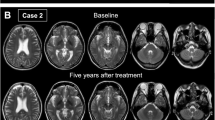Abstract
Background
Cerebrotendinous xanthomatosis (CTX) is an autosomal recessively inherited inborn error of metabolism (IEM) due to mutations in the CYP27A1 gene. The clinical picture ranges from being nearly asymptomatic in early childhood, up to severe disability at adult age. Infantile-onset diarrhea and juvenile-onset cataract are the earliest symptoms in childhood. In the current study, we evaluated the presence of autism spectrum disorder (ASD) in a large cohort of CTX patients.
Methods
We performed a retrospective patient file study in 77 genetically confirmed Dutch CTX patients to determine the frequency of ASD. In addition, we compared plasma cholestanol levels in CTX patients with and without a diagnosis of ASD and tried to establish a relation between CYP27A1 genotype and ASD.
Results
In our CTX cohort, 10 patients (13%; nine pediatric and one adult) with ASD were identified. At the time of diagnosis of ASD, most patients only exhibited symptoms of diarrhea and/or intellectual disability without signs of cataract or neurological symptoms. No correlation was found between the presence of ASD and the level of cholestanol or CYP27A1 genotype. The behavioral problems stabilized or improved after treatment initiation with chenodeoxycholic acid (CDCA) in all pediatric patients.
Conclusions
We conclude that ASD is an early and probably underestimated frequent feature in CTX. Metabolic screening for CTX should be performed in patients with ASD when accompanied by diarrhea, intellectual disability, juvenile cataract, and/or neurological involvement. Early recognition allows for earlier initiation of specific treatment and will improve clinical outcome. Our results add CTX to the list of treatable IEMs associated with ASD.

Similar content being viewed by others
References
American Psychiatric Association (2013) Diagnostic and statistical manual of mental disorders: DSM-V. American Psychiatric Publishing, Arlington
Barkhof F, Verrips A, Wesseling P et al (2002) Cerebrotendinous xanthomatosis: the spectrum of imaging findings and the correlation with neuropathologic findings. Radiology 217:869–876
Bianconi SE, Cross JL, Wassif CA, Porter FD (2015) Pathogenesis, epidemiology, diagnosis and clinical aspects of smith-Lemli-Opitz syndrome. Expert Opin Orphan Drugs 3(3):267–280
Björkhem I, Boberg KM (1995) Inborn errors in bile acid biosynthesis and storage of sterols other than cholesterol. In: Scriver CR, Beaudet AL, Sly WS, Valle D (eds) The metabolic and molecular basis of inherited disease. McGraw-Hill, New York, pp 2073–2099
De Sain-van der Velden MG, Verrips A, Prinsen BH, de Barse M, Berger R, Visser G (2008) Elevated cholesterol precursors other than cholestanol can also be a hallmark for CTX. J Inherit Metab Dis 31:387–393
Fraidakis MJ (2013) Psychiatric manifestation in cerebrotendinous xanthomatosis. Transl Psychiatry 13(3):e302
Ghaziuddin M, Al-Owain M (2013) Autism spectrum disorders and inborn errors of metabolism: an update. Pediatr Neurol 49(4):232–236
Mignarri A, Gallus GN, Dotti MT, Federico A (2014) A suspicion index for early diagnosis and treatment of cerebnrotendinous xanthomatosis. J Inherit Metab Dis 37:421–429
Mignarri A, Dotti MT, Federico A et al (2017) The spectrum of magnetic resonance findings in cerebrotendinous xanthomatosis: redefinition and evidence of new markers of disease progression. J Neurol 264:862–874
Monson DM, DeBarder AE, Bock CJ et al (2011) Cerebrotendinous xanthomatosis: a treatable disease with juvenile cataracts as presenting sign. Arch Opthalmol 129(8):1087–1088
Ragno M, Di Marzio F, Fuccio C et al (2015) Cerebellar hypometabolism with normal structural findings in Cerebrotendinous xanthomatosis. Clin Neurol Neurosurg 139:221–223
Rogers TD, McKimm E, Dickson PE, Goldowitz D, Blaha CD, Mittleman G (2013) Is autism a disease of the cerebellum? An integration of clinical and pre-clinical research. Front Syst Neurosci 7:15
Schiff M, Benoist JF, Aïssaoui S, Boespflug-Tanguy O, Mouren MC, de Baulny HO, Delorme R (2011) Schould metabolic diseases be systematically creened in nonsyndromic autism spectrum disorders? PLoS One 6(7):e21932
Schmahmann JD, Sherman JC (1998) The cerebellar cognitive affective syndrome. Brain 121:561–579
Sikora DM, Pettit-Kekel K, Penfield J, Merkens LS, Steiner RD (2006) The near universal presence of autism spectrum disorders in children with smith-Lemli-Opitz syndrome. Am J Med Genet A 140:1511–1518
Tierney E, Nwokoro NA, Porter FD et al (2001) Behavior phenotype in the RSH/smith-Lemli-Opitz syndrome. Am J Med Genet 98:191–200
Verrips A, van Engelen BG, Wevers RA et al (2000) Presence of diarrhea and absence of tendon xanthomas in patients with cerebrotendinous xanthomatosis. Arch Neurol 57:520–524
Author information
Authors and Affiliations
Corresponding author
Ethics declarations
Conflict of interest
Olivier Bonnot received honoraria from Actelion and Orphan Europe and is a board member for Actelion and Orphan Europe.
Aad Verrips received honoraria from serving as a consultant for Sigma-Tau Pharmaceuticals, Inc., USA and Sigma-Tau Rare Disease Limited, United Kingdom.
B. M. L. Stelten, H. H. Huidekoper, F. J. van Spronsen, P. M. van Hasselt, L. A. J. Kluijtmans, and R. A. Wevers declare that they have no conflict of interest.
Informed consent
The study was done in accordance with the Helsinki Declaration and approved by the Local Ethics Committee of the Canisius Hospital Nijmegen, the Netherlands. Informed consent was obtained.
Animal rights
This article does not contain any studies with animal subjects performed by any of the authors.
Additional information
Communicated by: Nancy Braverman
Rights and permissions
About this article
Cite this article
Stelten, B.M.L., Bonnot, O., Huidekoper, H.H. et al. Autism spectrum disorder: an early and frequent feature in cerebrotendinous xanthomatosis. J Inherit Metab Dis 41, 641–646 (2018). https://doi.org/10.1007/s10545-017-0086-7
Received:
Revised:
Accepted:
Published:
Issue Date:
DOI: https://doi.org/10.1007/s10545-017-0086-7




